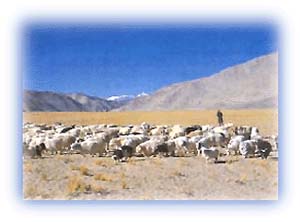Environmental Problems
General Info
Man-made problems
· Forest degradation
· Fires
· Quarrying
· Landslides
· Mountaineering
· Trekking
· Road construction
Natural Processes
· Earthquakes
· Glaciers
· Avalanches
· River and stream erosion

![]()
| Overgrazing Overgrazing by domestic animals like sheep, goats, cows, mules, horses and yaks has been responsible for large scale degradation of the vegetative cover in many parts of the Himalayas. Animal rearing is an important occupation in the mountains in areas where agriculture is difficult or not possible due to the environmental conditions. Moreover, there are many tribes like the Gujars and the Gaddis which make their living primarily by rearing animals. |
Domestic animals are reared for many purposes. Their milk is consumed directly or used to make milk products like butter and yogurt, which are sold in the markets. The meat is another item of consumption. The hide is also used, and in the case of the sheep, the wool is a commodity of great commercial value. Even the animal dung is useful as manure. And most importantly, the animals are beasts of burden and also used on the farms.
 |
| Shepherd with his stock in the not-so-green pastures. Credit: Discover India |
Overgrazing by domestic animals has adverse effects on the vegetation -- in the case of both alpine grasslands and forests. Due to this, the forests and the grasslands become bare and subsequently prone to soil erosion.
The animals graze during spring, when the seedlings of various tree species, grasses and herbs are growing. This leads to the problems of regeneration as the future crop is adversely affected.
Seedlings of various species can get crushed and trampled under the hooves of cattle. In some cases the roots of a tree species may be exposed by trampling. This results in the death of the desired species.
Selective grazing tends to alter the composition of the forest or grassland ecosystem, causing an increase in the population of undesired species, which are not consumed by the animals.
Indiscriminate grazing leads to the degradation of the soil. The soil becomes compact and the porosity is reduced. Soil aeration is also adversely affected. This in turn results in the seeds not germinating as they do not get sufficient air and water from the soil. Moreover, the hooves of the animals break down the soil aggregates, which gives a crumbly structure to the soil. Due to this, the soil loses its ability to absorb sufficient amounts of water. This translates into little percolation of rain water, most of which gets drained away. Since indiscriminate grazing leaves large parts of the land bare, the rainwater that gets drained away tends to erode the soil in its path. This degrades the soil further.
All rights reserved